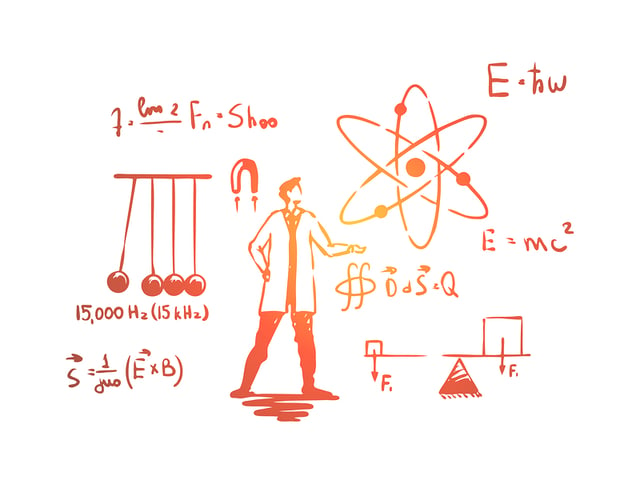
Helpful Formulas for the GED Science Test
Are you preparing for the GED Science Test? If so, you’re in luck! The focus of this test is on scientific skills, not rote memorization of lengthy formulas. But wait – that doesn’t mean you can simply ignore the formulas altogether! Even though the formulas will be given to you during the test, understanding how to use them is essential for success. The GED Science Test assesses your aptitude in Life Science, Physical Science, and Earth and Space Science. In this blog, we’ll help you become familiar with the various scientific formulas you might encounter and give you some key tips to tackle the test with confidence.
Emphasis on Scientific Skills
The GED Science Test is designed to measure your ability to understand, interpret, and apply scientific information. Unlike traditional tests that might require you to memorize complex equations or definitions, the GED places more importance on:
-
Problem-Solving Skills: How well can you analyze a situation and find the correct solution using scientific principles?
-
Interpretation of Data: Can you read and interpret graphs, tables, and charts that present scientific data?
-
Application of Scientific Concepts: Are you able to apply your knowledge in real-world contexts, such as predicting outcomes or explaining natural phenomena?
-
Investigative Approach: Can you design or evaluate a scientific investigation, recognizing the most reliable and valid methods?
The test promotes the practical use of scientific concepts rather than the mere recall of facts and figures.
Importance of Understanding Formulas
While memorizing formulas is not required, you must know how to handle and manipulate them. This involves more than simply plugging numbers into an equation; it requires understanding the underlying principles. Here’s how the right application of formulas can make the difference:
-
Physics Calculations: Knowing how to use formulas in physics means you can calculate things like force, acceleration, and energy. You’ll need to comprehend the relationship between variables and apply the correct formula to solve the problem.
-
Chemical Reactions: Understanding chemical formulas will help you recognize reactions, predict products, and calculate quantities in a reaction. You must be able to interpret what a formula tells you about the substances involved.
-
Mathematical Models in Biology: You may also encounter formulas related to growth patterns, population dynamics, or genetics. Interpreting these requires understanding the underlying biological principles.
The key here is not just to know the formulas but to comprehend their meaning and application. By practicing with real-life examples, you’ll gain the skills needed to interpret the given formulas during the test and answer questions accurately.
Formulas for the GED Science Test
Now, let’s take a look at the formulas you may encounter on the test. Remember, you won’t need to deal with all of these; we’ve listed all that you might possibly face.
| Category | Formula | Symbols | Comment |
|---|---|---|---|
| General Science and Statistics |
\(Du=Su \cdot \dfrac{Du}{Su}=Su \cdot CF\) | Du = Desired Unit Su = Starting Unit CF = Conversion Factor |
Multiple steps may be needed. |
| General Science and Statistics |
\(a \cdot b\% =a \cdot \frac{b}{100}\) | a = any real number b% = any percent |
Remember to simplify if necessary |
| General Science and Statistics |
\(\% = \frac{\vert b-a \vert }{b} \cdot 100= \frac{c}{b} \cdot 100\) | % = % increase or decrease a = new value b = original value c = amount of change |
|
| General Science and Statistics |
\(\overline{x}= \dfrac{\Sigma x_i}{n}\) | \(\overline{x}\) = mean \(x_i\) = value of each measurement n = number of measurements |
|
| General Science and Statistics |
\(Md=(\dfrac{n+1}{2})^{th} term\) | Md = median n = number of measurements (odd) |
|
| General Science and Statistics |
\(Md=\dfrac{(\frac{n}{2})^{th} term + (\frac{n+1}{2})^{th} term }{2}\) | Md = median n = number of measurements (even) |
|
| General Science and Statistics |
\(s=\sqrt{\Sigma(x_i-\overline{x})^2/(n-1)}\) | s = standard deviation \(\overline{x}\) = mean \(x_i\) = value of each measurement n = number of measurements |
|
| General Science and Statistics |
\(V=s^2\) | v = Variance s = standard deviation |
|
| General Science and Statistics |
\(CV=RSD=100 \cdot \dfrac{s}{\overline{x}}\) | CV = Coefficient of variation RSD = Relative standard deviation s = standard deviation |
|
| General Science and Statistics |
\(^\circ F\) = \(^\circ C \cdot \dfrac{9}{5} + 32^\circ\) or \(^\circ C = (^\circ F -32) \cdot \dfrac{5}{9}\) |
\(^\circ F\) = Degrees Fahrenheit \(^\circ C\) = Degrees Celsius |
|
| Physics | \(w=m \cdot g\) | w = weight (N) m = mass (kg) g = acceleration of gravity (\(\frac{m}{s^2}\)) |
|
| Physics | \(v=\dfrac{d}{t}\) | v = Velocity (\(\frac{m}{s}\)) d = distance (displacement) (m) t = time (s) |
|
| Physics | \(a = \dfrac{\Delta V}{\Delta t}\) | a = acceleration (\(\frac{m}{s^2}\)) \(\Delta V\) = change in velocity (\(\frac{m}{s}\)) \(\Delta t\) = change in time (s) |
|
| Physics | \(v = v_o + a \cdot t\) | v = Velocity (\(\frac{m}{s}\)) \(v_o\) = initial velocity (\(\frac{m}{s}\)) a = acceleration (\(\frac{m}{s^2}\)) t = time (s) |
|
| Physics | \(x = x_o + v_o \cdot t + \frac{1}{2}a \cdot t^2\) | x = position (m) \(x_o\) = initial position (m) \(v_o\) = initial velocity \((\frac{m}{s})\) t = time (s) a = acceleration \((\frac{m}{s^2})\) |
|
| Physics | \(v^2 = v_o^2+2a \cdot (x-x_o)\) | v = Velocity (\(\frac{m}{s}\)) \(v_o\) = initial velocity \((\frac{m}{s})\) a = acceleration \((\frac{m}{s^2})\) x = position (m) \(x_o\) = initial position (m) |
|
| Physics | \(f=m \cdot a\) | f = force (N) m = mass (kg) a = acceleration (\(\frac{m}{s^2}\)) |
|
| Physics | \(p=mv\) | p = momentum (\(\frac{kg \cdot m}{s}\)) m = mass (kg) v = velocity (\(\frac{m}{s}\)) |
|
| Physics | \(w = f \cdot d\) | w = work (J) f = force (N) d = distance (m) |
|
| Physics | \(P= \dfrac{w}{t}\) | P = power (W) w = work (J) t = time (s) |
|
| Physics | \(PE_g = m \cdot g \cdot h\) | \(PE_g\) = Gravitational Potential Energy (J) m = mass (kg) g = acceleration of gravity (\(\frac{m}{s^2}\)) h = height (m) |
|
| Physics | \(KE = \frac{1}{2} \cdot m \cdot v^2\) | KE = kinetic energy (J) m = mass (kg) v = velocity (\(\frac{m}{v}\)) |
|
| Physics | \(MA = \dfrac{Ld}{Ef} = \dfrac{Ld_d}{Ef_d}\) | MA = Mechanical Advantage Ld = Load (N) Ef = Effort (N) \(Ld_d\) = Load distance (m) \(Ef_d\) = Effort distance (m) |
|
| Physics | \(F_g = \dfrac{G \cdot M \cdot m}{r^2}\) | \(F_g\) = Gravitational force (N) G = Gravitation constant (\(6.67 \times 10^-11 N m^2/kg^2\)) M and m = masses of two bodies (kg) |
|
| Physics | \(F_b = r_f \cdot g \cdot V\) | \(F_b\) = Buoyant force (N) \(r_f\) = Density of fluid displaced (\(\frac{kg}{m^3}\)) g = Acceleration of gravity (\(9.8 \dfrac{m}{s^2}\)) V = volume of fluid \((m^3)\) |
|
| Physics | \(V=IR\) | V = potential difference (V) I = current (A) R = resistance (\(\Omega\)) |
Ohm’s Law |
| Physics | \(\lambda = \dfrac{v}{f}\) | \(\lambda\) = wavelength (m) v = velocity of wave (\(\frac{m}{s}\)) f = frequency \(\frac{1}{s}\) or Hz |
|
| Physics | \(Q = m \cdot c \cdot \Delta t\) | Q = Transferred heat (J) m = mass (g) c = specific heat capacity (\(\frac{J}{g \cdot K})\) \(\Delta t\) = change in temperature (K) |
|
| Chemistry | \(d=\dfrac{m}{v}\) | d = density (\(\frac{g}{cm^3}\)) m = mass (g) v = volume (\(cm^3\)) |
|
| Chemistry | \(^A_ZX\) | A = Mass Number Z = Atomic Number = Number of protons X = Atom symbol |
|
| Chemistry | \(A=Z+N\) | A = Mass Number Z = Atomic Number = Number of protons N = Number of neutrons |
|
| Chemistry | \(M=\dfrac{m}{n}\) | M = Molar mass (\(\frac{g}{mole}\)) m = (g) n = (moles) |
|
| Chemistry | \(K =\) \(^\circ C + 273\) | K = Kelvin temperature \(^\circ C\) = Celsius temperature |
|
| Chemistry | \(PV=nRT\) | P = Pressure of gas (units vary) V = Volume of gas (L) n = Number of moles (mol) R = Ideal Gas Constant (units vary) T = Temperature (K) |
|
| Chemistry | \(m_r=m_p\) | \(m_r\) = mass of reactants \(m_p\) = mass of products |
Preparing for the GED Science Test
Utilize Visual Aids
Creating flashcards or visual aids with the formulas can be a helpful tool for quick referencing and review. Visual learning engages your mind differently than mere reading, making complex information easier to grasp.
Here’s how you can maximize visual aids:
-
Use Colors and Symbols: Incorporate various colors and symbols to help distinguish different formulas and concepts. For example, use green for biology formulas, blue for physics, and so on.
-
Add Diagrams: Including relevant diagrams with formulas can help you understand how they apply in a real-world context.
-
Create Flashcards: Whether you’re at home, on a break at work, or commuting, flashcards provide an efficient way to keep key information fresh in your mind as you prepare for the test.
Collaborate with Peers
Study groups can provide different perspectives and methods of understanding the formulas. Collaborating with peers can expose you to various ways to approach problems. This collaborative learning approach can be highly beneficial:
-
Diverse Perspectives: Every individual has a unique way of understanding and applying concepts. Collaborative study helps you see problems from multiple angles.
-
Active Learning: Working with peers requires you to actively participate and explain your thoughts, enhancing understanding.
-
Mutual Motivation: Having a study group can keep you motivated and committed to regular study sessions.
Seek Guidance from Instructors
If you’re taking a GED preparation course, don’t hesitate to ask your instructors for clarification or assistance with specific formulas. They can provide additional insights and practice problems to help you master the material. Here’s how to make the most of your instructors’ support:
-
Ask Specific Questions: Rather than just asking for help, pinpoint the exact area you’re struggling with. This will help your instructors provide targeted assistance.
-
Request Practice Problems: If you’re finding a particular formula challenging, ask for additional practice problems. Applying the formula in various contexts will cement your understanding.
-
Take Advantage of Office Hours: If your instructor offers office hours, utilize this time for one-on-one help. A dedicated session can provide personalized insights tailored to your needs.
Get Ready for GED Success!
The GED Science Test challenges your ability to think scientifically rather than to remember facts and formulas. However, familiarity with the essential formulas is necessary for success. By following the guidance and practices laid out in this blog, you will be well on your way to conquering the GED Science Test. Embrace the formulas, apply them through practice, and head into your test with confidence!
Keep Reading

General Education Development Test Blog
Can You Join the Military with a GED?
The GED was created in 1942 to help members of the military and vetera…

General Education Development Test Blog
Is the GED Harder Than High School?
Are you wondering if a GED diploma is right for you? You aren’t alone: …

General Education Development Test Blog
How is the GED Scored?
Each year, roughly 59% of people who take the GED, a popular high schoo…